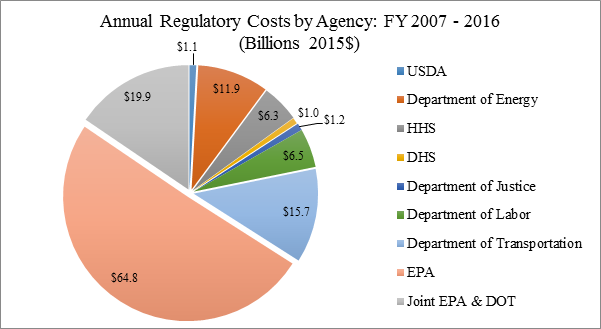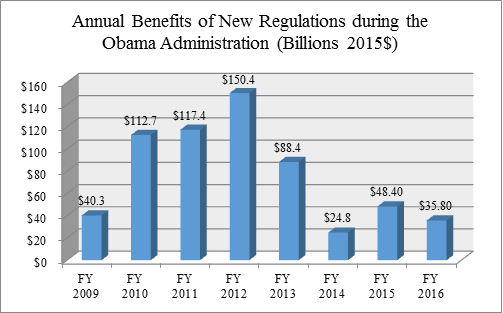By: Sofie Miller
On Friday, the Office of Management and Budget released its Draft Report to Congress on the Benefits and Costs of Federal Regulations (“the Report”), which provides a window into regulatory activity conducted by federal agencies toward the end of the Obama administration in Fiscal Year 2016. The Report indicates that new regulations issued in the last full fiscal year of the previous administration involve lower annual costs and benefits than in FY 2015, and that toward the end of the Obama administration the Environmental Protection Agency (EPA) remained by far the largest contributor to both regulatory costs and benefits in this Report.
How Fiscal Year 2016 Measures Up: Regulatory Costs & Benefits
The Report starts with basic regulatory accounting: In the 10 years between fiscal year 2007 and FY 2016, agencies published 36,255 final rules, of which 2,670 (or 7%) were significant and underwent regulatory review at OMB. Of these OMB-reviewed rules, 609 were “major” rules.
Importantly, the Report only includes benefit or cost information for 137 rules. In other words, it only includes 22% of all major rules, and less than half of 1% of all rules issued during that decade. According to agency estimates, these 137 major rules add up to $930.3 billion in annual benefits and $128.4 billion in annual costs (2015$).
Similar to other reports, EPA regulations accounts for a significant portion of both regulatory costs and benefits between Fiscal Years 2007 and 2016: EPA contributed just over 75% of annual regulatory benefits and 50% of annual regulatory costs during this period. There are also more rules from EPA in the Report than any other agency: 28% of the 137 rules in the report are from EPA, two-thirds of which are rules from the Office of Air and Radiation that account for the greatest proportion of both regulatory benefits and costs.

Benefits & Costs during the Obama Administration
The 2017 Report covers regulatory costs and benefits for the final fiscal year of the Obama administration but does not capture the last four months—the so-called “midnight regulation” period (during which, as we have documented elsewhere, regulatory agencies issued a record number of regulations). Relative to other years of his administration, FY 2016 represents somewhat lower regulatory benefits and costs than in previous fiscal years.

Regulatory Reforms Affect Accounting
The rules included in this report are those issued by previous administrations—namely George W. Bush and Barack Obama. As a result, the regulatory benefit and cost totals don’t include the regulatory reforms that have been implemented during the first year of the Trump administration.
On the contrary, the Report includes two rules that have since been overturned by Congress using the Congressional Review Act: The Federal Acquisition Regulation Council (FAR) rule “Fair Pay and Safe Workplaces,” and the Securities and Exchange Commission’s (SEC) rule “Disclosure of Payments by Resource Extraction Issuers.” The Report indicates that the FAR rule would have resulted in an estimated $400 million in annual costs, and neither the FAR nor the SEC rule included information on monetized benefits.
OMB notes that it opted to include these rules in the Report “to provide an estimated, but not necessarily realized, impact of the rules finalized during the fiscal year the Report covers.” The Report also includes a number of regulations that the Administration may reconsider.
Increased Emphasis on Retrospective Review
As in previous Reports, OMB emphasizes the importance of retrospective review for ensuring regulatory outcomes are achieved and avoiding unnecessary regulatory burdens. Despite the fact that retrospective review “can be important as a corrective mechanism” for the flaws in prospective analyses, OMB notes that previous efforts at retrospective review have not always been successful. Executive Orders 13771 and 13777 may address some of these shortcomings by institutionalizing review and requiring agency lookback before agencies can proceed with new rules.

